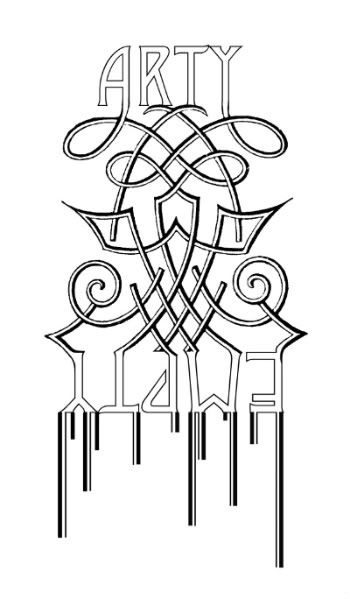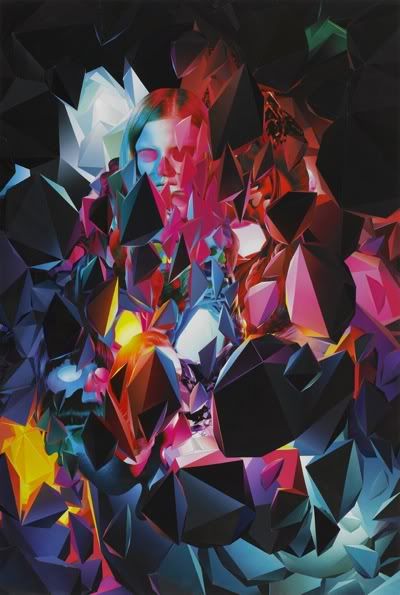En ce moment, il fait froid. Mais pas aussi froid que dans d’autres pays. En Norvège par exemple, il fait bien plus froid. Même à Olso qui est au sud du pays ; mais au nord de l’Europe. La Norvège, un pays où la scène artistique, d’ailleurs, est bien vivace. Voilà. Après avoir frôlé le lancement le plus nul de toute l’histoire de la critique d’art (frôlé car on en connaît un autre au moins aussi nul….), on peut légitimement évoquer une scène norvégienne qui a su s’exporter, menée par quelques leaders capables d’ouvrir la voie en défrayant la chronique.
La scène artistique norvégienne a un père fondateur en la personne d’Edvard Munch. Initiateur de l’expressionnisme, Munch laisse planer l’ombre de sa forte personnalité sur toute la création norvégienne qui l’a suivi. Difficile en effet de se défaire d’une telle ombre. Avant lui, pas grand monde à part peut-être, pour les enfants et les fans de Burzum (qui peuvent être les mêmes personnes…. Heureux parents !), Theodor Kittelsen, illustrateur génial dans un style simple et déjà terriblement expressif, notamment dans la série The Black Death. Sous le joug de ce fort passé expressionniste, les créateurs actuels ont su dégager un style propre et indépendant. Nul doute que l’omniprésence de la nature, la splendeur sombre des forêts, la lumière froide, la nuit émerveillée ne peut qu’avoir une influence forte sur la création de tout artiste norvégien et scandinave en général. Certes sans doute un peu cliché, mais pas tant que cela quand on connaît la violence envoûtante des paysages nordiques. Il n’y a qu’à s’apercevoir qu’ils ont crée la (deuxième) scène black metal pour comprendre un peu mieux les interactions que peut jouer la nature sur l’humeur des norvégiens…
De cette nouvelle jeune scène norvégienne (qui ne bénéficie pas de projecteurs aussi puissants et factices que ceux ayant illuminé les anglais, les allemands, puis les chinois, les indiens, les russes….avant les français ?), quelques personnalités se détachent nettement.
Parmi eux, Borre Saethre est un exemple évident de l’utilisation onirique des merveilles de la nature. Licorne (My private sky), lapin dévergondé (a million dreams, a million scars / interlude : poerty for satelites, dont le malheureux lagomorphe de Bunny Session), corbeaux (Beauty’s summer dead), biches (the end of Bambi cycle), Saethre crée un univers fantasmagorique, inquiétant, aseptisé comme dans un film de Kubrick.
La star montante est sûrement le jeune artiste Gardar Eide Einarsson. Son travail sur les sous-cultures et la manière dont elles s’insèrent dans un champ politisé peut sembler, à prime abord, assez froid et abrupt. D’autant plus qu’Einarsson adopte un style néo-conceptuel des plus distancés. Il n’empêche, le traitement empreint d’accidents, de non-fini / infini, et de laisser-aller punk fait ressortir, derrière sa complexité apparente, une émotion sensible.
Dans une attitude néo-conceptuelle et rock assez proche, on retrouve Matias Faldbakken, autre jeune norvégien prometteur. Utilisant l’esthétique minimaliste en particulier dans des écritures au scotch sur toile (untitled canvas #16), Faldbakken préserve le recul nordique tout en réinsérant ironiquement l’expressivité traditionnelle norvégienne (cultural department).
Lars Laumann s’intéresse à d’étranges interconnections qui parcourent la culture populaire et qui tissent des liens improbables entre eux : Lady Di et The Smiths dans Morrissey foretelling the death of Diana, l’étonnante histoire d’amour entre la suédoise Eija-Riitta Berliner-Mauer et… le mur de Berlin dans Berlinmuren. Laumann est dans une optique plus ouverte que ses confrères et propose une lecture très personnelle mais toujours intéressante de phénomènes sociaux décryptés.
Dans une veine plus traditionnelle d’évocation d’un passé mythologique riche et encore très présent, on retrouve deux artistes aux pratiques antagonistes. Aux dessins classiques et classieux de Martin Skauen tout en relents de magie sulfureuse (My atlas, Arctic monkey) s’opposent les tremblements bruts de Bjarne Melgaard. Le travail de Melgaard transpire de soubresauts fulgurants dans une peinture parcourue des forces ancestrales de la Norvège mythique (bien qu’il soit né à Sydney).
En parlant de magie, les collages d’Are Mokkelbost en sont emplis. Il met au service d’une technique hors du commun une esthétique à part et étonnamment colorée. Une telle perfection dans un mélange pourtant hétéroclite doit forcément relever d’un quelconque rituel viking.
Il resterait à parler des dessins légers et fantastiques au premier sens du terme de Kim Hiortoy et des photographies parfaitement travaillées tout en restant dans une réalité surprenante de Torbjorn Rodland. Comme cela, la (néanmoins très bonne) galerie Standard d’Oslo pourrait légitimement nous remercier chaleureusement de cet article….
Enfin, peut-on réellement et déontologiquement évoquer Ingar Dragset, la moitié du duo qu’il forme avec le danois Michael Elmgreen ? Oui, pour deux raisons. La première, parce qu’ils sont géniaux dans leur humour intelligent et leur dérision conceptuelle. La seconde, parce que, étant donné que c’est le talent qui compte, on se fout complètement de la nationalité d’un artiste.
Au fait, ne prenez pas froid et couvrez-vous, ils annoncent de la neige pour la semaine prochaine….
Norway: Growth of the soil.
One of these is Borre Saethre, an obvious example of a dream-like use of Nature marvels. Unicorn (My private sky), debauched rabbits (a million dreams, a million scars / interlude: poerty for satelites, including the unfortunate one on Bunny Session), ravens (Beauty’s summer dead), does (the end of Bambi cycle), Saethre creates a shadowy universe, frightening, sterilized as a set on Kubrick’s movies.
Gardar Eide Einarsson is probably the rising star. He works on subcultures and how they integrate to politicized domain. His pieces look firstly a little bit cold and abrupt, especially when he adopts distanced neo-conceptual style. But, the way he uses accidents, an unfinished / infinite, punk drifted manner, shows, behind its apparent complexity, a sensible emotion.
On a similar neo-conceptual and rock attitude, we find Matias Faldbakken, another young promising Norwegian artist. He utilizes a minimalistic aesthetic, particularly on his scotch-tape writings on canvas (Untitled canvas #16). Faldbakken preserves Nordic detachment and reintegrates ironically the traditional Norwegian expressiveness (Cultural Department).
Lars Laumann is interested in strange interconnections linking unlikely popular cultures together: Lady Di and The Smiths on Morrissey foretelling the death of Diana, the surprising love story between the Swedish Eija-Riita Berliner-Mauer and…. the Berlin Wall on Berlinmuren. Laumann is on a more opened vision than his colleagues and proposes a very personal and interesting reading of decoded social phenomenon.
On a more traditional vein that alludes to a rich mythological but still present past, we have two antagonist artists. The classical and classy drawings by Martin Skauen, full of sulfurous magic (My Atlas, Arctic Monkey) are opposed to the brut thrills of Bjarne Melgaard. The work of Melgaard leaks out dazzling jolts on a painting covered with ancestral forces of Mythical Norway (even if he is born in Sydney).
Talking about magic, the collages of Are Mokkelbost are a good example. Thanks to an out of the common technique, he develops a different and colorful aesthetic. Such a perfection on an heteroclite mix must be a part of some Viking rituals.
We have to evocate the light and fantastic (first sense of the word) drawings of Kim Hiortoy and the perfectly worked but still on an astonishing reality photographs by Torbjorn Rodland. Thus, the (nevertheless very good) Standard Gallery in Oslo could legitimately thanks us wholeheartedly for this article….
Lastly, can we ethically mention Ingar Dragset, half of the duet he composes with the Danish Michael Elmgreen? Yes, we can, for two main reasons. The first one, because they are geniuses, using clever humor and conceptual scorn. The second one, because, considering that only talent matters, we absolutely do not care about the nationality of an artist.
By the way, don’t catch a cold and cloak yourself, snow is announced for next week….



Aucun commentaire:
Enregistrer un commentaire